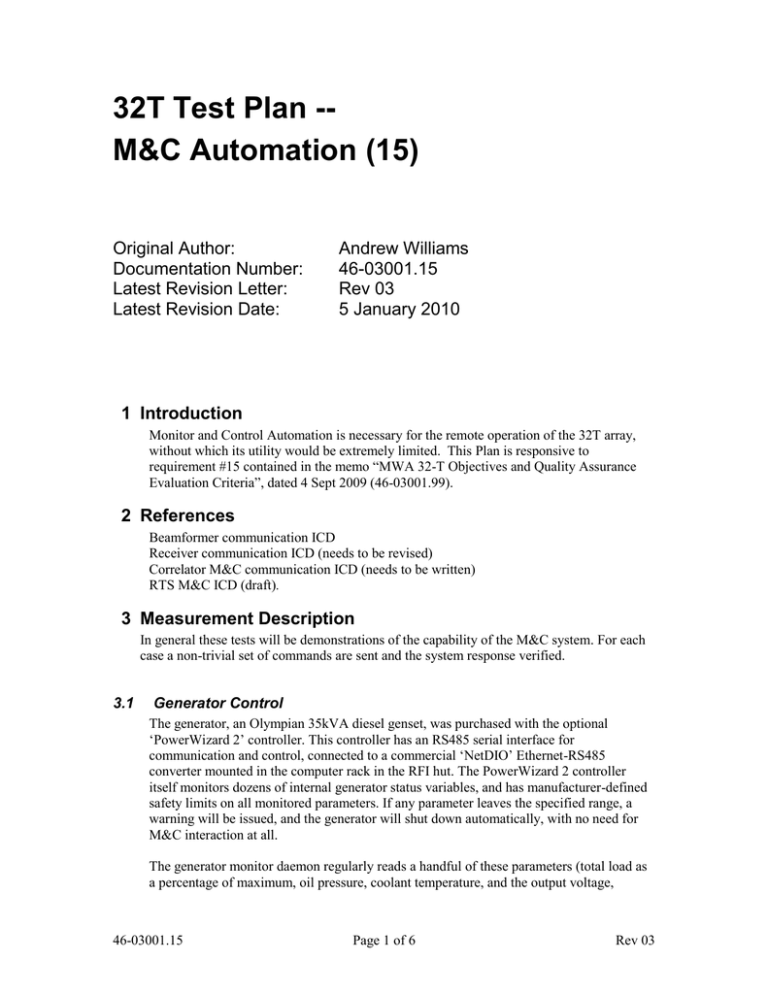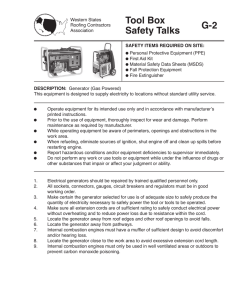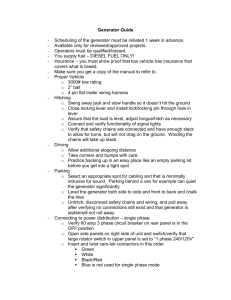32T Test Plan -- M&C Automation (15)
advertisement

32T Test Plan -M&C Automation (15) Original Author: Documentation Number: Latest Revision Letter: Latest Revision Date: Andrew Williams 46-03001.15 Rev 03 5 January 2010 1 Introduction Monitor and Control Automation is necessary for the remote operation of the 32T array, without which its utility would be extremely limited. This Plan is responsive to requirement #15 contained in the memo “MWA 32-T Objectives and Quality Assurance Evaluation Criteria”, dated 4 Sept 2009 (46-03001.99). 2 References Beamformer communication ICD Receiver communication ICD (needs to be revised) Correlator M&C communication ICD (needs to be written) RTS M&C ICD (draft). 3 Measurement Description In general these tests will be demonstrations of the capability of the M&C system. For each case a non-trivial set of commands are sent and the system response verified. 3.1 Generator Control The generator, an Olympian 35kVA diesel genset, was purchased with the optional ‘PowerWizard 2’ controller. This controller has an RS485 serial interface for communication and control, connected to a commercial ‘NetDIO’ Ethernet-RS485 converter mounted in the computer rack in the RFI hut. The PowerWizard 2 controller itself monitors dozens of internal generator status variables, and has manufacturer-defined safety limits on all monitored parameters. If any parameter leaves the specified range, a warning will be issued, and the generator will shut down automatically, with no need for M&C interaction at all. The generator monitor daemon regularly reads a handful of these parameters (total load as a percentage of maximum, oil pressure, coolant temperature, and the output voltage, 46-03001.15 Page 1 of 6 Rev 03 current, and frequency) and logs them in both Nagios (the system monitoring and alert facility) and Graphite (time series graphing and analysis), two open source packages used for M&C. The Nagios facility is configured to send warning emails to a predefined list of addresses when any of these parameters exceed specified limits, so that the issue can corrected before an automatic shutdown. For controlling the generator, there is one simple command, ‘genset’ with the parameter ‘on’ or ‘off’. Testing: Connect a laptop computer to the solar-powered network switch in the RFI hut, log into the gateway computer, type ‘genset on’ and verify that the generator turns on. Check that the collected generator parameters (load percentage, etc) as logged and displayed by Nagios agree with the LCD display on the generator itself. Confirm that Nagios issues automatic emailed warnings when the total load drops below the warning threshold (exceeding any of the other parameters can not safely be tested). Issue the ‘genset off’ command and verify that the generator turns off after the three minute cooldown period. All of this functionality was demonstrated on the X8 site visit in July 2009. 3.2 Air Conditioners The same ‘NetDIO’ module that handles the Ethernet-RS485 for generator communication also has 7 bits of digital I/O for hardware control. These go to a custom buffer and relay board in the rack. Currently two output bits are used, connected to proprietary Fujitsu switch boxes, one for each air conditioner in the RFI hut. A trivial command (‘aircon’), which takes ‘on’ or ‘off’ as a parameter, is used to control these bits. This is called by a script run automatically on boot to ensure the air conditioners are switched on when the generator is running. Testing: Issue the ‘aircon on’ and ‘aircon off’ commands and verify that the air conditioners turn on and off. Verify that the air conditioners turn on automatically when the generator starts. This functionality was demonstrated on the X8 site visit in July 2009. 3.3 User interface and Schedule Database A PostgresSQL database server stores the ‘schedule database’, which is a precise description of the desired future configuration of the entire MWA telescope system. As well as the schedule database, other tables store monitored status data, and other details. The current user interface to the schedule database is a library (schedule.py) and a couple of command-line programs that use that library to define ‘observations’. A set of dynamic web pages allow the contents of the schedule database to be viewed in detail. Testing: 46-03001.15 Page 2 of 6 Rev 03 Use the command line tools (single_observation.py, takeup.py) to add observations to the database and verify that the correct configuration information is written to the schedule database using the web GUI and raw SQL queries. This test can be carried out in parallel with any other tests or observing that require observations to be defined. This functionality was verified in July 2009 on the X8 site visit. 3.4 HP 8642 Synthesiser The HP 8642 synthesiser is used to provide the base A/D sampling frequency for the system. When the system is first powered up, the synthesiser defaults to a default state with the output off, and must be configured correctly. During observations of Orbcom satellites the default (655.36MHz) frequency must be slightly altered, to put the satellite transmitter frequency in the centre of the wide frequency bands. This is managed using a commercial Ethernet-GPIB converter, and an interface library running on the M&C server. A command-line client allows the frequency and attenuation to be set or queried, and a ‘cron job’ automatically uses this client to check the receiver status and log it every few minutes. Testing: Verify that the synthesiser is configured correctly after a reboot. Use the client to change frequency and attenuation, and verify that the front-panel display on the synthesiser corresponds to the desired values Verify that the synthesiser configuration is being regularly logged to the database This functionality was verified on the July 2009 X8 site visit. 3.5 Receivers The observation controller daemon runs on the M&C server and communicates with all the receivers, sending them appropriate configuration data as defined in the schedule database. A separate process running on the M&C server collects status data from the receivers, processes and logs it. Testing: Configuration test: defining a set of future observations in the schedule database and verifying that the correct configuration data is sent to the receivers. Status test: Verifying that the receiver status data logged by the receiver client matches the status data archived to the database by the status monitor daemon. 3.6 Correlator The correlator will not require any configuration or management by M&C. The only M&C interface will be to monitor and log internal correlator status (temperatures, processing statistics, etc) using a daemon running on the M&C server that communicates with the correlator via TCP. Testing: Verify that correlator performance data is being logged. 46-03001.15 Page 3 of 6 Rev 03 3.7 Real-Time System The M&C interfaces required for the Real-Time System are: Initialisation and shutdown, to be handled by custom scripts ‘ssh’ing to the RTC and running the appropriate commands. The RTS will be stopped and restarted at the beginning of each distinct observation (change of frequency, attenuation, or pointing). All configuration data will be passed in a single text file defined in the RTS ICD Monitoring and logging RTS status by parsing syslog messages from the RTC Flagging bad data, eg during dead time when hardware changes state. Implementation is yet to be determined, but will probably be a combination of direct PostgreSQL queries by the RTS and a TCP socket connection between an M&C daemon process and the RTS. Testing: Initialisation and shutdown to be verified directly by checking whether the RTS is running. Configuration parameter passing will be verified by comparing the RTS configuration text file written by M&C with the required parameters from the schedule database. Syslog parsing verified by comparing syslog file contents to logged RTS status in the database. Data flagging to be verified by analysing the captured science data and verifying that flagged time periods have not been included. 4 Resources Required 4.1 Staffing Operation of the MWA currently requires at least one person on site (two to satisfy minimum OH&S requirements). Since the user interface to the M&C system is functionally and practically identical for both on-site and off-site users (an ‘ssh’ connection and a web browser), most M&C specific tests can be carried out either by one of the staff on site, or by a remote user. The exceptions are low level hardware functions (generator control, air conditioning) that can simply be verified in person by whoever is on-site. In addition, most of the tests can be carried out in combination with other hardware and software system tests. Ed Morgan, Chris Williams, or Andrew Williams are all capeable of carrying out the M&C tests. 4.2 Hardware To demonstrate the bulk of the M&C capabilities we will do the required testing off site in the lab at Curtin University. These tests will require: One receiver, connected to one beamformer, connected to one dipole The M&C server The HP 8642 Synthesiser and prototype receiver clock generator Some form of prototype data acquisition system Full M&C testing will be done on-site and requires: The generator The RFI hut and air conditioners 46-03001.15 Page 4 of 6 Rev 03 4.3 The NetDIO box and associated relay/buffer electronics in rack case The 12V solar powered gateway computer The M&C server Two receivers, each connected to several tiles The HP8642 synthesiser and prototype receiver clock generator The correlator The RTC/RTS prototype Software The following software is required: NetDIO communications libraries and client programs for air conditioner and genset control Nagios (open source) installed and configured PostgreSQL installed and configured, with all required tables and constraints Schedule database interface libraries (schedule.py, etc) User interface client programmes (single_observation.py) Web interface CGI code to view the schedule database Observation controller daemon Status monitor daemon Web interface CGI code to view the receiver status Receiver client code Internal firmware for receiver components (ADFB, AGFO) Correlator status monitor daemon RTC/RTS initialisation/shutdown scripts M&C interface daemon to communicate with RTS RTS daemon process to communicate with M&C 4.4 Execution Time and Constraints Most M&C functionality has already been demonstrated. Most of the remaining tests should be carried out in parallel with other tests or observing, to optimise the use of available time. 5 Success Criteria I’ve described the test criteria above, where it’s trivial – where it’s not trivial (eg, analysis of recorded data to verify frequency), I have no idea how to describe specific tests or results Exactly what is needed here that isn’t defined in the descriptions of the tests themselves? (AW) 46-03001.15 Page 5 of 6 Rev 03 Revision History Rev Ltr Date 01 2009-09-14 02 2009-09-15 03 2010-01-05 46-03001.15 Author AW AW RFG Description Basic draft Removed receiver client from M&C work and testing Formatting Page 6 of 6 Rev 03




